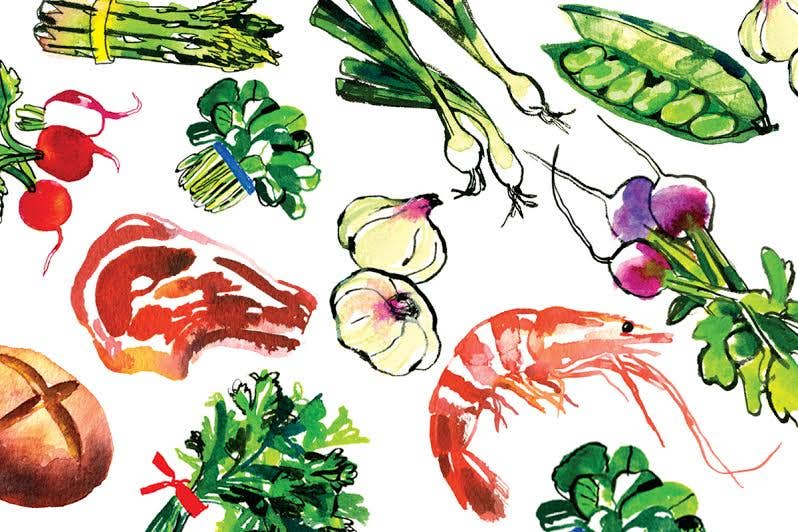
Crown of Thorns
The majestic saguaro—the tallest cactus in America—is a virtual tree of life for one Arizona Indian tribe.
A word to the wise: Picking the fruit of the saguaro cactus is not for the faint of heart. At Saguaro National Monument West, near Tucson, Arizona, there are thorns everywhere. And scorpions. And rattlesnakes.
There is another danger, too: not showing the saguaro respect. Do that, and you will raise the hackles of Stella Tucker. When I lunge at a saguaro with a 16-foot harvesting pole, Tucker, a Tohono O'odham Indian, bristles. "Be careful," she says sharply. "You'll hurt it."
The Tohono O'odham, whom the Spanish called the Papago and who have lived in this part of the Sonoran Desert for centuries, revere the saguaro. In O'odham tradition, the saguaro owes its origin to a small boy who fell into a hole and emerged as a giant cactus. Ever since, the Tohono O'odham (the name means "desert people") have considered the saguaro human and have viewed its qualities—its reserve, its dignity—as worthy of emulation. There was once a time when an O'odham, after picking a saguaro fruit, would bow to the cactus in gratitude.
Although the O'odham rely on any number of edible plants—including beans, corn, and squash—they regard the saguaro as virtually a tree of life. Its fruit provides them with food, its ribs with kindling, and its flesh with a balm for sores and rashes. And the saguaro has loomed even larger in O'odham culture. Fermented saguaro syrup yields the wine still used every year in that holiest of O'odham rites, the annual rainmaking festival. Each August, the wine ceremony is conducted by the tribe's medicine men. They instruct the O'odham to drink saguaro wine "as the earth drinks rain"—a process said to bring on the summer monsoons that assure the tribe one more harvest.
But times have changed. When Tucker was a child (she is now 49), nearly every O'odham village had its rainmaking festival. Now only a few uphold the custom. And though there are about twenty thousand O'odham in the United States, most of them on three reservations in southern Arizona, only a few pick the saguaro fruit anymore. And for many of those who still do, it's a casual occupation, an exercise that fills a few hours at most. "People are no longer interested," says Edith Franklin, Tucker's aunt. "They'd rather watch TV."
But not Tucker. She still gathers the fruit the old way, spending much of June and part of July every year at a harvesting camp in Saguaro National Monument West. The camp is fairly primitive, comprising a ramada (a makeshift open-air shelter), a portable toilet, several camp beds, a picnic table, plastic chairs, and an old barrel doing service as a wood-burning stove. There is no electricity.
Twice a day, shortly after dawn and again at sunset, Tucker heads for the saguaro groves to gather fruit. It's a test of skill. The saguaro is the largest cactus in the United States and can attain heights of 30 or 40 feet when mature. The green, oval-shaped fruits are found on the saguaro's upper reaches. Arranged in clusters on its arms and crown, they look from a distance like birds' nests. To reach the fruits, the picker uses a harvesting pole—two saguaro ribs lashed together with baling wire—resembling a lance. The pole is laid against the saguaro and pushed upward, which is not as easy as it sounds. Unless you're experienced in this art, the pole assumes a life of its own, oscillating wildly above your head. When Tucker hands me mine, I feel a bit like Don Quixote off to joust with windmills.
With the exception of a small area in California, the only place that the saguaro (Carnegiea gigantea) is found in this country is Arizona, where it is a protected species. Although the cactus can produce as many as 10 million seeds a year, only one in 50 million seedlings successfully becomes a mature saguaro. Those who move the cactus without the proper authority or who abuse it face stiff penalties. Tucson developers, when building on desert land where saguaros grow, must dig up and replant the cactus safely some-where else. Some saguaros live to be 200 years old, but they grow very slowly: They are at least 40 when they produce their funnel-like white blooms for the first time, and about 75 when they sprout arms. Pack rats love the saguaro, Tucker says. For them, and for several other small mammals, it's a good source of food. For hawks and wrens and white-tailed doves (all of which nest in it), the cactus is also home.
To wander through a saguaro grove is to imagine yourself in a vast sculpture garden filled with the work of an artist obsessed with Gumby. On this particular morning, Tucker, wearing purple slacks, white running shoes, and a brown T-shirt, is at the top of her game. A robust and good-humored woman, she's so accomplished at managing the harvesting pole that she has only to nudge the fruits ever so slightly to pry them loose. "Look," says Franklin. "They're like rain coming down."
Also helping Tucker is Jordan Antone, an 11-year-old relative. Delegated to catch the falling fruits, he stands under the saguaro with a raised bucket. But he isn't always successful. Sometimes they miss the pail and strike him on the head. When this happens, Tucker and Franklin laugh mightily. Two things distinguish the O'odham, says anthropologist Ruth Underhill: They laugh a lot and they rarely shout. I ask Tucker if the latter is true, and she looks surprised. "I don't think anyone should raise their voice. Do you?"
Several of the fruits burst open when they hit the ground, their extruded red interiors giving them the look of orchids. Others lodge in the branches of neighboring paloverde trees and hang there like stricken birds. With Franklin's help, Tucker discards the skins and stores the fruits' pulpy cores in a plastic bucket. The reddish orange pulp has the porous texture of coral. "Try one," Tucker tells me. The taste, slightly anonymous, is somewhat reminiscent of watermelon.
When the heat mounts—at noon it's already 95 degrees in the shade—Tucker returns to the camp and makes a syrup, placing most of the gathered pulp in a large pot, adding water, and simmering the mixture over a wood fire until it thickens and the flavors concentrate. On average, two buckets of fruit and a bucket of water will produce a quart of syrup, which is then strained twice, once through a sieve and again through cheesecloth, to eliminate the saguaro's black seeds. A single fruit may contain as many as two thousand seeds, which are no bigger than sturgeon roe. Rich in oils, the seeds are ground to make a kind of porridge or used as chicken feed. Franklin says her chickens love them. "They can't get enough. [When they eat the seeds,] they just lay and lay and lay...."
Not all of the pulp goes into the syrup pot, however. Some is arranged on pallets and left in the sun to dry. The end result tastes like dried figs, and part of it is eaten as snack food. The rest is rubbed between the fingers to remove the seeds and produce saffronlike strands called fiber. The fiber is then combined with the syrup to make saguaro jam. (Because it is a part of their cultural tradition, the O'odham have a special dispensation to harvest saguaro fruit on national parkland, but neither the syrup nor the jam made from it may be sold commercially.)
In color, saguaro syrup resembles raspberry cordial, and the taste, often compared to that of molasses, is slightly metallic. I'm regarded with horror when I put some syrup in my coffee—with good reason, it turns out. It tastes awful. Left to ferment for three days, the syrup becomes wine, which, if not consumed promptly, turns to vinegar.
While Tucker often speaks fondly of the past, she could never be accused of not moving with the times. Breakfast this morning consists of Cheerios and pork chops, and lunch is Gatorade and pizza. Later in the afternoon, she slips home in her 1985 Oldsmobile—bought from the Cherokee Motors dealership—to shower and to catch the television news. Yet she remains, for all that, a fervent champion of tradition. "I'm going to come to this camp and harvest saguaro for as long as I can," she says. And when she can't do it anymore? "My three daughters will take over," she says quickly. The eldest is in Phoenix, the second studies clothing design in New York, and the third, still in high school, lives with her mother in Tucson.
"But will they be interested?" I ask. "I hope so," she says, frowning just a little and sounding less than certain. And then her expression clears. "Yes, I'm sure they will be. They love the culture as much as I do."
Keep Reading
Continue to Next Story










